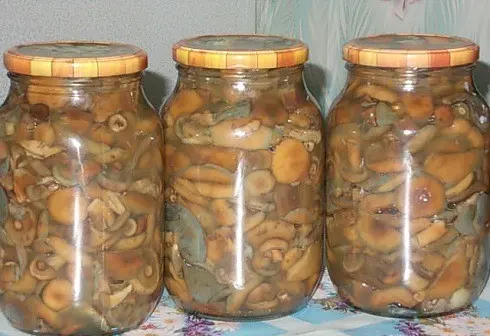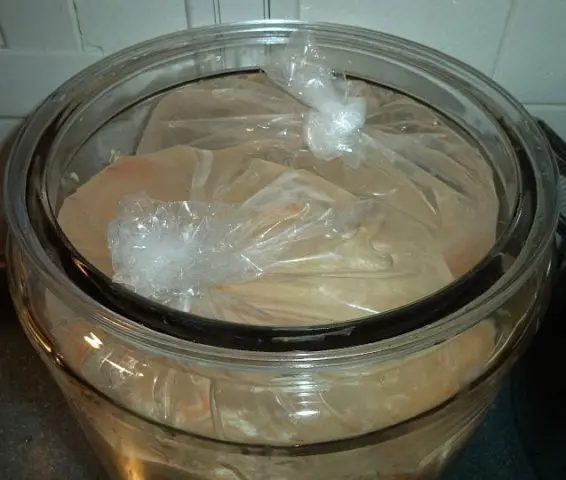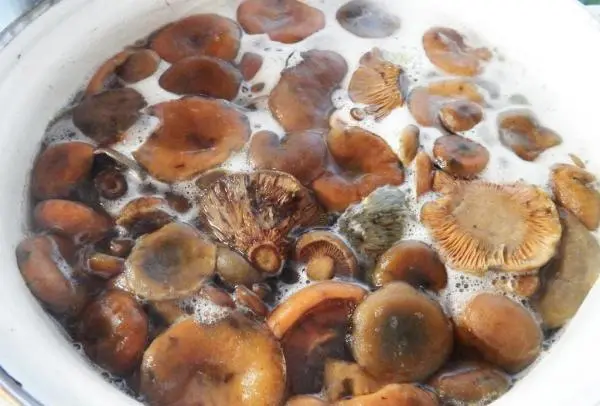Contents
Mushrooms are called royal mushrooms for their incomparable taste and aroma, and also because they do not require any soaking or heat treatment when salted. Therefore, most often mushrooms are harvested for the winter with the help of salting. Nevertheless, many housewives are faced with a situation where everything seemed to be done correctly and according to the recipe, and the mushrooms turned sour. What this means, what reasons can lead to souring, and what can be done about it – will be discussed further.

Why did the redheads wander
Ryzhik can wander for a variety of reasons. It also happens that the signs of normal fermentation, which can be considered standard when pickling mushrooms, are taken by many novice housewives as dangerous symptoms. So, if after several days of being under oppression, a thin strip of mold appeared on the surface of the mushrooms, then you should not worry too much. This is an almost normal process that occurs due to contact with atmospheric oxygen. And in any recipe that describes the salting of mushrooms in a cold way, it is necessarily said that during the period of fermentation under oppression (3-5 weeks), once every 2-3 days, the fabric covering the mushrooms and the press itself must be washed. It is best to boil them in a little water or even use a new cloth.
A similar situation can happen when it seems that the saffron mushrooms have fermented in the jars, where they were transferred after a short stay under oppression. If the fermentation process has not ended (and it needs from 2 to 6 weeks, depending on the temperature), then bubbles may appear on the surface of the brine, and the brine itself will begin to slowly flow out of loosely covered jars. This is completely normal. You just need to strictly follow the instructions for keeping salted mushrooms under pressure. It is important here to check whether the mushrooms are sour or not. In the first case, it is necessary to take effective measures. If the taste of the brine has not changed, then the mushrooms are quite edible, and you just need to wait.
But often there is such a situation that you have to keep jars with mushrooms that have not yet grown good in the refrigerator, since it is difficult to find another equally cold place. In this case, the jars should be placed in additional containers or in tight plastic bags so as not to stain the refrigerator shelves. But sooner or later (on average, after 3-4 weeks), the fermentation process will still stop and it will be possible to weaken the control over salted mushrooms and no longer be afraid that they will turn sour.
Another thing is if salted mushrooms turn sour from non-compliance with certain rules for harvesting or storage.
Many housewives, by inertia, like to soak mushrooms in water before salting. After all, this procedure is required by all types of mushrooms, and other agaric mushrooms. But mushrooms are very negative about this procedure. They belong to edible mushrooms of the 1st category and do not need soaking at all. It is not for nothing that the best classic way of salting mushrooms is dry, that is, without access to water at all. Therefore, if the mushrooms become sour during salting, then it is necessary, first of all, to remember whether they were left unattended in the water for some time. This could negatively affect their structure and lead to subsequent souring.
In the process of salting mushrooms, it is imperative to use oppression. Since it is he who helps to constantly keep the mushrooms under the surface of the brine. If some parts of the mushrooms are not immersed in brine, then the likelihood that they will turn sour and mold will appear will increase many times over. Most often, only oppression itself sticks out of the brine. Since it comes into contact with the camelina brine and air at the same time, it is precisely for this reason that it must be periodically removed and thoroughly washed with hot water so that the mushrooms do not acidify. This factor is especially important when using cold and dry salting.

Finally, a suitable air temperature and lighting conditions are very important under which salting and subsequent storage of mushrooms takes place. When light hits containers with mushrooms, they can easily turn sour. The same happens when the storage temperature rises above + 6 °C.
What to do with mushrooms if they are sour
If, nevertheless, salted mushrooms are sour after the end of the fermentation period, then the following can be done with mushrooms:
- Remove them from the container, rinse under running water and place in a pot of boiling water, to which add 30 g of salt and 5 g of citric acid per 1 liter of water used.
- Drain all the previous liquid, rinse the container thoroughly with soda and rinse with boiling water.
- Boil the mushrooms for about 7-10 minutes, then put them in a colander and let the excess liquid drain.

- Prepare a fresh brine based on the fact that 1 tablespoon of rock salt is dissolved in 1 liter of water.
- In a sterilized jar, put ½ tsp. mustard seeds, place mushrooms on top and pour fresh brine.
The taste of salted mushrooms will change slightly from the addition of mustard, but will not spoil the overall picture at all.
By the way, when looking for an answer to the question of what to do with pickled mushrooms if they ferment, you can use the same advice. It is only necessary to fill them with a fresh marinade, in which for safety it is better to add a little more vinegar.
How to salt mushrooms so that they do not turn sour
So that salted mushrooms do not ferment, it is necessary from the very beginning to take the salting procedure with all responsibility, clearly following all the cooking instructions.
First of all, if dry salting is not used, it is necessary to carefully free the mushrooms from plant debris and especially particles of earth or sand with water. But it should be remembered that at the same time it is not worth soaking mushrooms in water for a long time.
Many housewives use exclusively hot salting so that the mushrooms do not turn sour. That is, mushrooms are boiled before salting, or at least doused with boiling water.
Salt must be added at the rate of 10 l bucket of mushrooms – 1,5 cups.
Since salt is the main preservative, it is better to overdo it a little than undersalt it. Salt solution will not allow the mushrooms to sour. And if it is too salty, then when using mushrooms, you can lightly rinse them in cold running water.
The container for salting should be enameled, glass, ceramic or wooden. Under no circumstances should metal utensils be used.

Finally, the most important thing is that it is imperative to make sure that when salting, all mushrooms are necessarily covered with brine. They are placed in the prepared container as tightly as possible, sprinkled with salt and spices and crushed until abundant juice is released. If suddenly natural mushroom juice is not enough, then add brine and be sure to put oppression on top. The press must be selected so that its weight is enough to ensure that all the mushrooms disappear below the liquid level.
In room conditions, salted mushrooms can stand for no more than a day to start the fermentation process. Then they are rearranged in a cold place, otherwise they will certainly turn sour.
While under pressure, it is necessary to constantly monitor the color of the brine. It should have a reddish hue and an attractive mushroom aroma. If the color has changed and turned gray, then this means that the mushrooms could turn sour, so urgent rescue measures must be taken.
Conclusion
If mushrooms are sour, then you should not immediately throw them away. First you need to understand the situation and find out what was done wrong. Maybe this is generally the normal state of mushrooms during fermentation. And if not, then the situation may be quite correctable. You just need to put in some extra effort.










